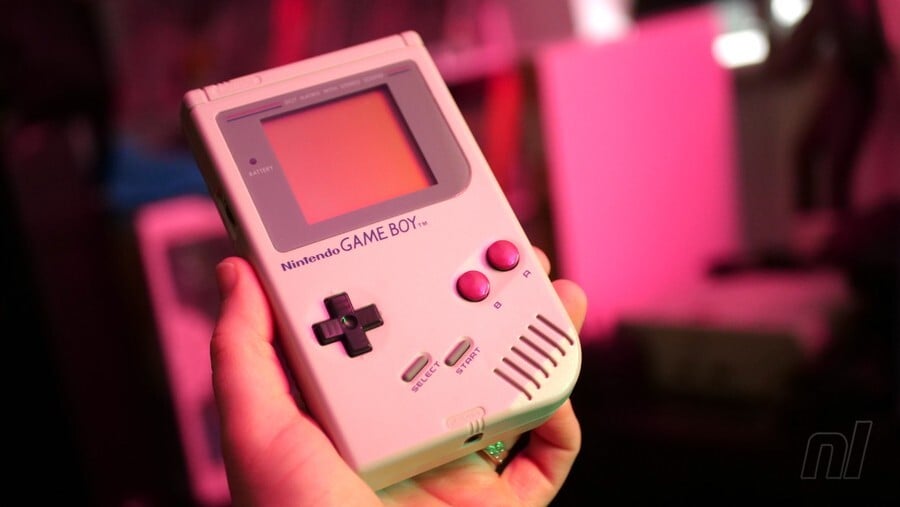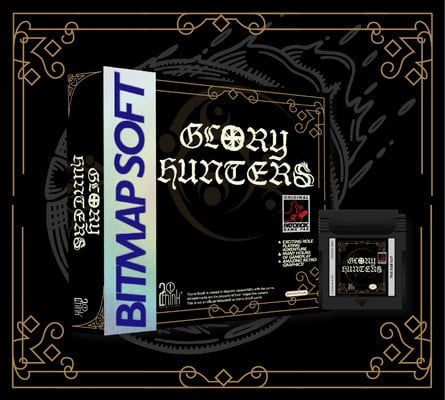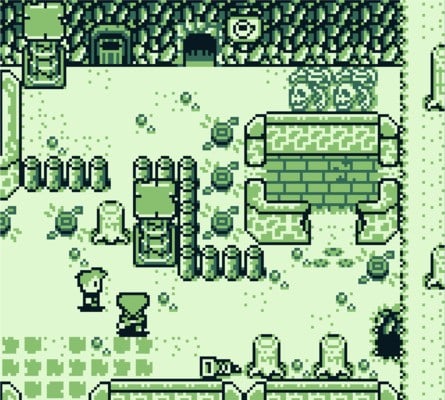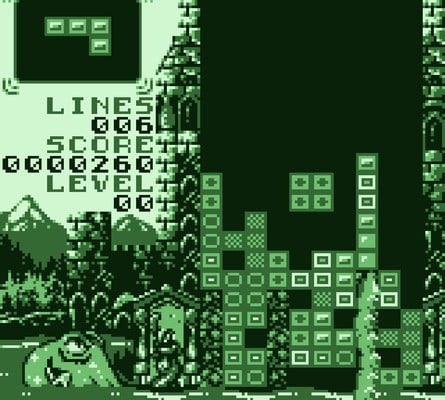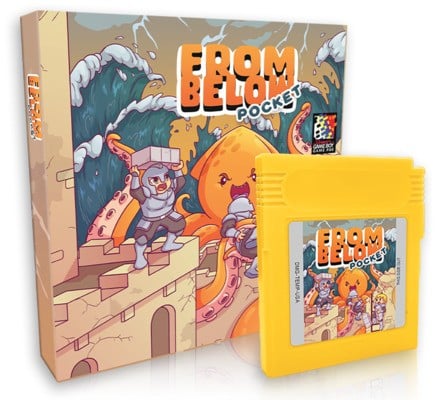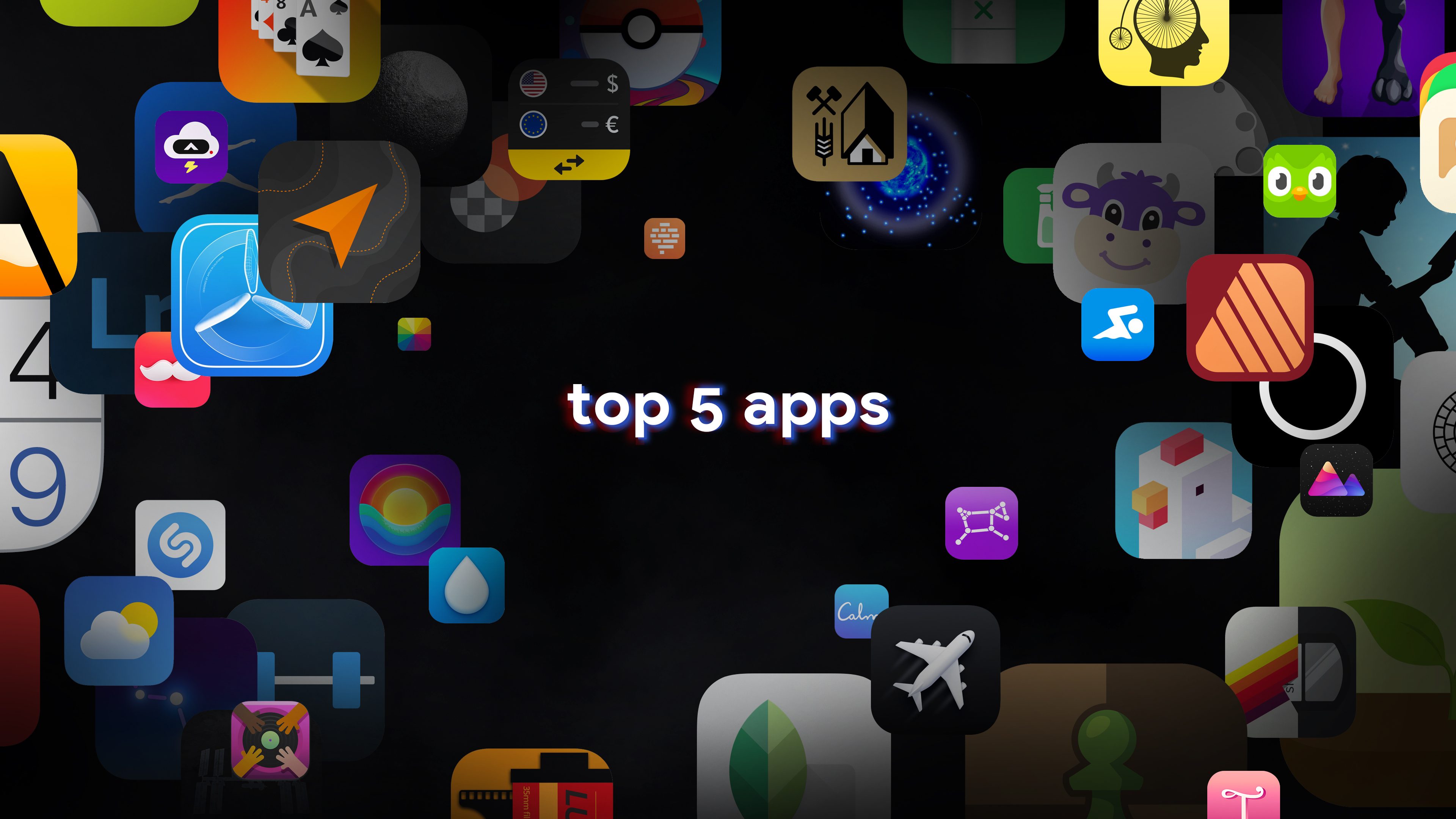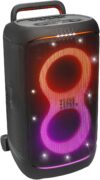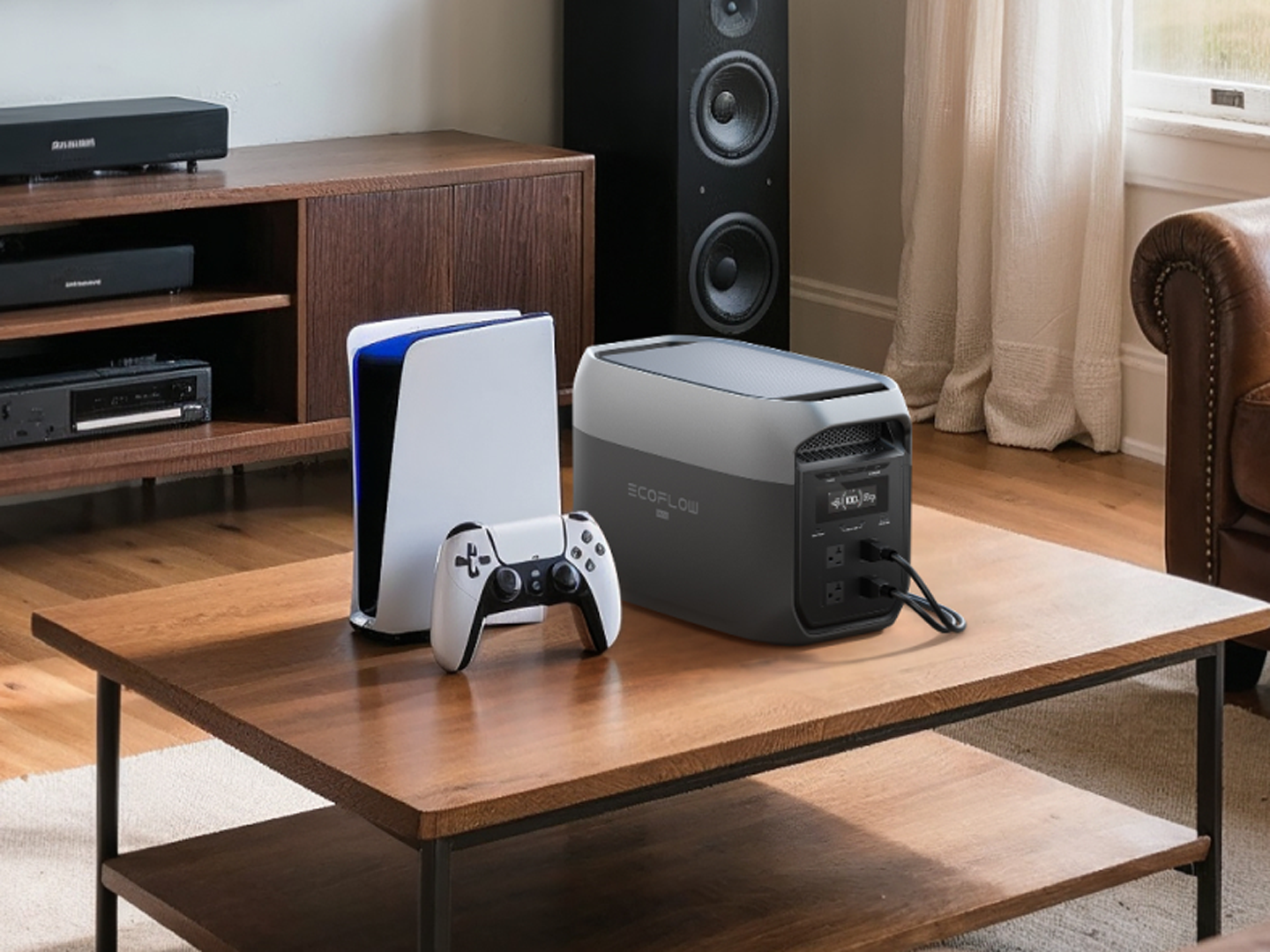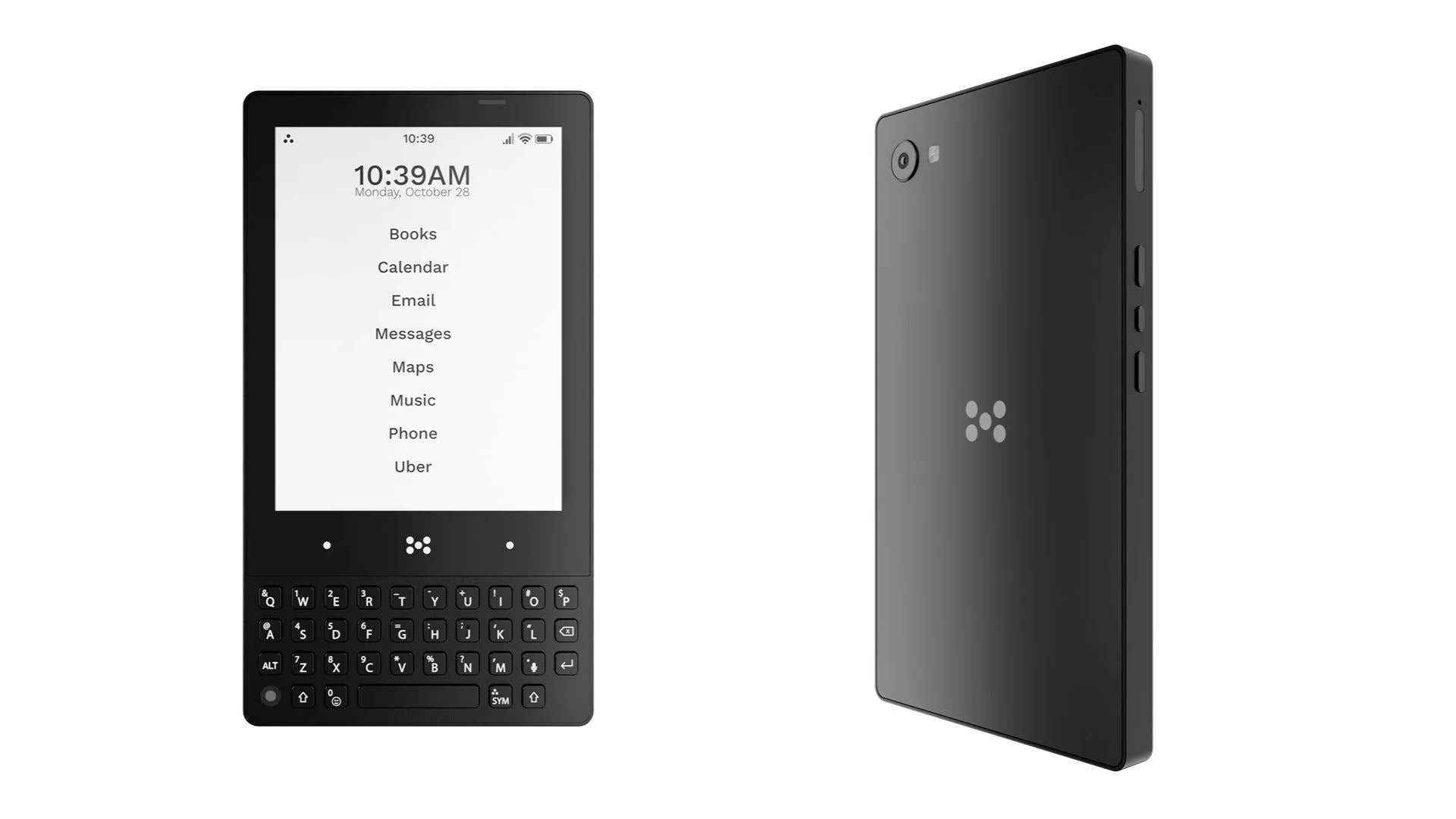
Wow! So you’re creating the game with GB Studio? Is this a completely solo effort or are you making it as part of a team?
The game is being created in GB Studio version 3.1.0, using tiles to create the map, sprites for NPCs, and animations. I partnered with my neighbour Rodrigo Nuñez – he’s a musician and is a part of a Celtic music band, so he knew a lot about the tunes used for that mood. I told him about the game and he created over 23 tracks. After that he recreated the original soundtrack with his band which you can hear on Spotify. I also teamed up with a good friend who I worked with on Pato Box, his name is Antonio Gutierrez and he’s dedicated to porting the game once I’m finished. Everything else, the sprites, the story, the programming I am doing myself.
GB Studio is of course designed to be very user-friendly, have you found that you’re bumping up against its limitations at all or is it doing everything that you want it to do?
It obviously has some limitations. For example, having to optimise the game so it fits into 4mb is quite the challenge. People are always surprised at how small that is, smaller than pictures on a phone sometimes. The game will last around 24 hours, that part was really challenging. It is really easy because it’s drag-and-drop but as I didn’t have any experience as a programmer, I don’t know any language code so I needed to get familiarised with the process – the logic of creating the game.
You were kind enough to share a demo build with us and I was really struck by the progression system. It reminded me of The Frog for Whom the Bell Tolls – not that you progress in the same way, but in that it feels familiar to something like The Legend of Zelda but with a vastly different approach to navigating through the world.
I played a bit of that while researching for the game. The controls play like the first Legend of Zelda because I couldn’t make something really complex with the limitations. The currency system you could compare to an EXP points system – I studied a lot about how Dragon Quest 1 worked and translated that into achievement points instead of experience by killing enemies. The visuals are based on games like Final Fantasy Adventure, and Link’s Awakening. Some of the assets are based on the Mother series and even Pokémon.
How did the idea for the achievement system come about?
I’m a World of Warcraft player so for me the achievement system within video games started there, but the idea was really born from A Link to the Past on the SNES – a specific part in the game when you had to drop rupees over and over again to upgrade bombs and arrows and I remember always as a kid trying to do that first. It was grindy but I really enjoyed having that reward of repeating the same action over and over again. That was the origin of the idea for Glory Hunters – to have certain events or challenges that you could repeat over again and scale into experience or currency you could use to open the world freely. That’s evolved but it’s the origin of the idea.
The game is having a physical release through Bitmap Soft – how did that partnership come about?
I joined the first GB competition on itch.io in 2021 and the demo was a finalist among 137 entries. After that I was contacted on Twitter by Bitmap Soft which was one of four or five publishers at the time creating new games for retro consoles. They said they were interested in the game, I told them I loved their games and that would be awesome – but I wanted to create a Kickstarter to reach more people. Together we figured out the campaign, I would create the game and they would make it physically for all the backers, and after that they would keep producing the game based on demand. The Kickstarter was in 2022 and we made about 130% of our target.
How is development going? Are you confident in reaching your 2024 target?
Originally development was meant to last one year but my second son was due to come into the world. Mixing children with all that happened with COVID, having COVID myself – a lot of issues has meant we are now two years into development.
Finally, while we’ve been chatting I can’t help but admire that Game Boy behind you – it’s enormous!
Yeah, it’s about one metre tall. It actually works – we’ve been taking it to events with original Game Boys for people to try out the game. It’s a lot of work creating an indie game without any money, but it’s been awesome to see people playing it.
What I’ve noticed is that many of the people who are interested in the game or the Kickstarter seem to be parents, people like me who grew up with a Game Boy, a simple system with a few buttons. They want a new experience with a familiar console and to share that with their kids. I’ve created the game with that in mind. You can get gratification in short bursts because parents don’t have a lot of time. You can complete the game within a few hours by getting to one corner of the map and defeating a god, but then if you want to go deeper down the rabbit hole it’ll take a lot more time. There’s an unlock and a ‘good’ ending. I’d love to know how many people see it.
Next up is Matt Hughson, whose game-dev day job has him working at The Coalition. A prolific designer in the homebrew NES scene, Matt took on the challenge of porting one of his best-known titles, From Below, to the Game Boy using the ZGB and GBDK2020 libraries.
Nintendo Life: Hi Matt, tell us a bit about yourself and how you got into developing games.
Matt Hughson: I’m in my 40s so I grew up with the NES, Game Boy, all that stuff – that’s kind of a cornerstone of my childhood, the heyday of Mario Mania. After childhood I got pretty into the NES in the late ’90s when emulation kind of exploded, I ran some emulation websites and then went to Full Sail School in Florida for game design where I earned my degree. Despite its name it is not a sailing school, which seems to confuse everyone I talk to, they teach digital media which is super common now but when I went back in 2001 it was quite a novelty, there were no game programs at national universities, it was really only Digipen and Full Sail. From there I came back to Canada, first working in a school then transferring to Electronic Arts – bouncing around companies in Vancouver and I’m now at Microsoft working on the Gears of War franchise.
You mention your love for the NES – I believe you’ve made games for the NES before?
Yeah, as I mentioned I’ve been working for about 20 years professionally in the industry and then I started getting into NES development around 2020 just as a hobby thing. I released From Below for the NES in 2020, then my next game was Witch n’ Wiz, kind of a puzzle platformer also for the NES. Then I switched over to the Game Boy for From Below Pocket. Now I’m back on the NES for an action platformer called Super Sunny World which is a kind of love letter to NES Mario games.
You ported From Below from the NES to the Game Boy – what made you decide to do this and what challenges did you face when porting it?
I guess the root motivation was that I love the Game Boy. And I think maybe a technical reason I was interested in doing a port was because I write most of my games in C instead of Assembly – which most old games were written in. Now to rewrite them in C you pay the cost of performance. I wrote From Below for the NES 99% in C with some bits from some Assembly libraries and then there are also libraries for the Game Boy which allow you to compile C, so I could take the core engine and just compile the game on the Game Boy with little to no work for the core gameplay. So that interested me, the thought that I could take the exact same game and run it on Game Boy – though there’s obviously a lot more work to it than that.
The two biggest challenges were the resolution change and the multiplayer. It’s lower resolution than the NES, the Game Boy’s about 144 [pixels] high and 160 wide whereas the NES is 256 by 240 – so basically cut in half. In addition to that, for the Tetris-style gameplay the traditional board is 10 blocks wide and 20 blocks high; on the Game Boy render is 8×8 sprites, so if you do the math you can’t actually fit that in on the Game Boy screen.
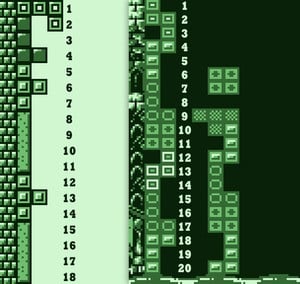
So if you look at the Nintendo Tetris board for the Game Boy, it is only 10 wide and 18 high, which is not really the traditional gameplay – so I wanted to kind of fix that. I did a bunch of technical tricks to essentially squish the screen so instead of being 144 pixels high it’s about 180 pixels high and I do it by skipping rendering every 8th scanline – so instead of 8×8 sprites, it’s essentially 8×7 sprites. So if you look closely the blocks aren’t actually square they’re slightly squished. That was a bit of a technical challenge and it kind of messes with the logic a little but it means that From Below is, as far as I know, the only game on the Game Boy that has the full 10×20 game board.
On top of that I wanted to add multiplayer and that was by far the hardest part of the game – a peer-to-peer game where you’re sending one byte at a time, it’s really complicated. And I had it easy! I had libraries I was building on top of and a lot of the low-level stuff was done for me but there were still tons of bugs and loads of edge cases to deal with.
The Game Boy is well known for its block puzzle games – you’ve mentioned the full-size board which makes it unique amongst its predecessors but tell us a little more about it and what makes it different.
So the core hook is this Kraken monster at the bottom of the screen and he’s pushing his tentacles up from the bottom of the ocean onto the gameboard. As he does so he’s pushing a row of blocks up as well as leaving garbage blocks on the board while you’re clearing. If you clear a line over his tentacle he retreats – so this push and pull adds a twist to it. And on top of that, there’s the idea that sometimes he can help you – he can push blocks into empty spaces which normally you wouldn’t be able to reach, so you can use him to your advantage as well.
One of the core design philosophies I was aiming for was taking modern design sensibilities and adding them to this classic game, so if you play classic Tetris or Game Boy Tetris, there are a lot of modern things that you might forget or might not realise are missing – things like wall kicks, lock delay so you can slide the block when it lands, little things like that to make it feel really good and fluid. Recently someone played Tetris for hours and hours to ‘beat’ the game – you can play at the highest level and it never gets harder. To combat that scenario and keep the games relatively short, once you reach level 30 there’s basically a soft kill screen. So every level you beat the floor slowly rises so you have a smaller space to work with. By the time you reach level 40 you’re essentially forced to play in the top third of the level while everything below it is locked – it’s basically impossible because it’s lightning fast at that point too, but it’s intentional to make it so you get as many points as you can before that point and then you have a bit of a ‘soft’ chance to maybe score a few more lines. At that point, lines in Tetris are worth tons of points so it just ensures that nobody’s going to have to play this game for four hours to get the world record. The longest play is 20 minutes or so.
As I ended up nearing completion, a bunch of the hardcore NES Tetris players found it and they started giving me feedback so a lot of what I’ve talked about is from them. I had no idea that stuff existed, I just kept feeding off them and pushing more and more into the game until it felt really good. I’m so thankful they found it because there was lots of stuff that was totally broken that would’ve just ruined the game for high-level Tetris players.
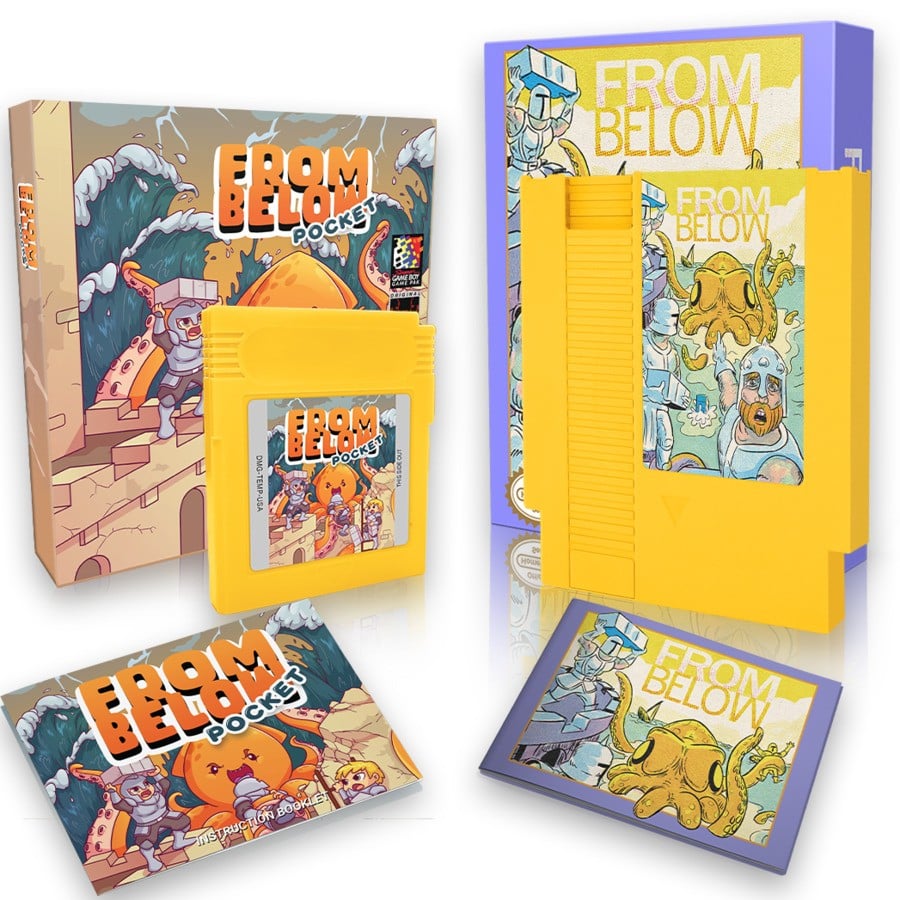
Do you have a world record scoreboard currently?
I think it’s two million. It’s on my Discord – I keep it there. I think someone hit that last year, which is just insane to me.
You had a limited run on cartridges – did you do that yourself or were they produced for you?
It was a bit of a mix. For the original NES game I did a super limited run of 100 copies and the first 50 I basically did myself. I contacted a guy on Etsy who made boxes and they turned out to be in Vancouver. I bought the PCBs from Broke Studio in France and I ordered the shells from China. It was an amalgamation for that first 50 which was a ton of work and really stressful, and if one doesn’t work you’re kind of screwed.
So for the second run I just went through Broke Studio because they also do the complete-in-box service, the shipping and everything. I did eBay for those batches; for the Game Boy version and a rerelease of the NES version I set up my own store, took all the orders, and passed that on to Broke Studio who did the manufacturing and distribution for me. Witch n’ Wiz before went through Limited Run Games.
Super Sunny World for the NES is your current project – what’s the release date for that and do you have any plans for the Game Boy after that?
I’m hoping to release this summer. When I started it was meant to be a one-month project – that was a year ago. I wanted to do something quick, a little homage to Mario 1, but it went so well that I decided to keep working on it. It’s really close to done – I have all the levels done, all the core gameplay is done, I’m just working on bosses which is taking a long time and I want to do some meta-game stuff. Finding hidden collectibles, maybe a slot machine to buy in-game items like Smash Bros. – something like that.
Then I’d love to return to Game Boy. I’d love to do a Witch n’ Wiz port. It’s kind of like a spiritual successor to Catrap – it takes the core concept of Catrap for the first ten levels but then every ten levels after I switch the mechanics. You can loop around the edge of the screen for the next ten levels like Asteroids, later on you can flip gravity. Catrap was such an awesome game I feel like Witch n’ Wiz would be too. I was also thinking of doing a Super Sunny port like a Super Sunny Land similar to Super Mario Land – not a straight port but a reimagining on a smaller screen. I just need to get this done first!
Finally, 7FH has seen five physical Game Boy releases in a variety of different genres and is a dab hand at squeezing magic out of the tiny portable using the GBDK2020 library.
Nintendo Life: Hi 7FH, tell us a bit about yourself and how you got into developing.
7FH: I’m 42 and come from Germany. Around 2019, I discovered the GBDK (Game Boy Development Kit), which allows you to develop your own Game Boy games using C. I was fascinated by the idea of creating my own game, so I looked around for tutorials and code examples.
You’re a prolific Game Boy creator with five physical releases to date. Tell us a little about each game.
All my games are developed using the GBDK. It delivers only a few basic functions but no complete game engine. Developing the game engine is one of the most fun parts.
- Genesis (2020) is a vertical scrolling shoot ‘em up mostly inspired by Solar Striker.
- Black Castle (2020) is an action platformer. It’s said to be a mixture of Super Mario Land and Castlevania.
- Gunship (2021) is a vertical-scrolling rail shooter. This type of game hardly exists on the Game Boy, which prompted me to develop such a game.
- G-Zero (2022) is a F-Zero-like racing game. I found one day an F-Zero pixel art demake on the internet which inspired me.
- Genesis 2 (2024) is the successor to Genesis. Genesis got some bad reviews… it was my first game and I didn’t know the hardware that well yet. So I wanted to prove that I can do it better.
Do any of the other games draw inspiration from other Game Boy titles you’ve enjoyed?
Genesis 1 and 2 also take inspiration from Nemesis 1 and 2. You can tell that from the name alone. Black Castle picks up on some elements of the Ghost ‘n Goblins game series.
Wow! So you’re creating the game with GB Studio? Is this a completely solo effort or are you making it as part of a team?
The game is being created in GB Studio version 3.1.0, using tiles to create the map, sprites for NPCs, and animations. I partnered with my neighbour Rodrigo Nuñez – he’s a musician and is a part of a Celtic music band, so he knew a lot about the tunes used for that mood. I told him about the game and he created over 23 tracks. After that he recreated the original soundtrack with his band which you can hear on Spotify. I also teamed up with a good friend who I worked with on Pato Box, his name is Antonio Gutierrez and he’s dedicated to porting the game once I’m finished. Everything else, the sprites, the story, the programming I am doing myself.
GB Studio is of course designed to be very user-friendly, have you found that you’re bumping up against its limitations at all or is it doing everything that you want it to do?
It obviously has some limitations. For example, having to optimise the game so it fits into 4mb is quite the challenge. People are always surprised at how small that is, smaller than pictures on a phone sometimes. The game will last around 24 hours, that part was really challenging. It is really easy because it’s drag-and-drop but as I didn’t have any experience as a programmer, I don’t know any language code so I needed to get familiarised with the process – the logic of creating the game.
You were kind enough to share a demo build with us and I was really struck by the progression system. It reminded me of The Frog for Whom the Bell Tolls – not that you progress in the same way, but in that it feels familiar to something like The Legend of Zelda but with a vastly different approach to navigating through the world.
I played a bit of that while researching for the game. The controls play like the first Legend of Zelda because I couldn’t make something really complex with the limitations. The currency system you could compare to an EXP points system – I studied a lot about how Dragon Quest 1 worked and translated that into achievement points instead of experience by killing enemies. The visuals are based on games like Final Fantasy Adventure, and Link’s Awakening. Some of the assets are based on the Mother series and even Pokémon.
How did the idea for the achievement system come about?
I’m a World of Warcraft player so for me the achievement system within video games started there, but the idea was really born from A Link to the Past on the SNES – a specific part in the game when you had to drop rupees over and over again to upgrade bombs and arrows and I remember always as a kid trying to do that first. It was grindy but I really enjoyed having that reward of repeating the same action over and over again. That was the origin of the idea for Glory Hunters – to have certain events or challenges that you could repeat over again and scale into experience or currency you could use to open the world freely. That’s evolved but it’s the origin of the idea.
The game is having a physical release through Bitmap Soft – how did that partnership come about?
I joined the first GB competition on itch.io in 2021 and the demo was a finalist among 137 entries. After that I was contacted on Twitter by Bitmap Soft which was one of four or five publishers at the time creating new games for retro consoles. They said they were interested in the game, I told them I loved their games and that would be awesome – but I wanted to create a Kickstarter to reach more people. Together we figured out the campaign, I would create the game and they would make it physically for all the backers, and after that they would keep producing the game based on demand. The Kickstarter was in 2022 and we made about 130% of our target.
How is development going? Are you confident in reaching your 2024 target?
Originally development was meant to last one year but my second son was due to come into the world. Mixing children with all that happened with COVID, having COVID myself – a lot of issues has meant we are now two years into development.
Finally, while we’ve been chatting I can’t help but admire that Game Boy behind you – it’s enormous!
Yeah, it’s about one metre tall. It actually works – we’ve been taking it to events with original Game Boys for people to try out the game. It’s a lot of work creating an indie game without any money, but it’s been awesome to see people playing it.
Gracias @EGS_Mexico por el espacio y a todos los que vinieron a probar la gloria del #Gameboy. Una experiencia mágica con todos los visitantes y desarrolladores mexicanos! Hasta la gloria siempre! #EGSSurvivall #EGSmexico #EGS2023 #Zonaindie #entertainmentgamingshow pic.twitter.com/NUgQnyijBM— 2think design studio (@2think_ds) November 20, 2023
What I’ve noticed is that many of the people who are interested in the game or the Kickstarter seem to be parents, people like me who grew up with a Game Boy, a simple system with a few buttons. They want a new experience with a familiar console and to share that with their kids. I’ve created the game with that in mind. You can get gratification in short bursts because parents don’t have a lot of time. You can complete the game within a few hours by getting to one corner of the map and defeating a god, but then if you want to go deeper down the rabbit hole it’ll take a lot more time. There’s an unlock and a ‘good’ ending. I’d love to know how many people see it.
Next up is Matt Hughson, whose game-dev day job has him working at The Coalition. A prolific designer in the homebrew NES scene, Matt took on the challenge of porting one of his best-known titles, From Below, to the Game Boy using the ZGB and GBDK2020 libraries.
Nintendo Life: Hi Matt, tell us a bit about yourself and how you got into developing games.
Matt Hughson: I’m in my 40s so I grew up with the NES, Game Boy, all that stuff – that’s kind of a cornerstone of my childhood, the heyday of Mario Mania. After childhood I got pretty into the NES in the late ’90s when emulation kind of exploded, I ran some emulation websites and then went to Full Sail School in Florida for game design where I earned my degree. Despite its name it is not a sailing school, which seems to confuse everyone I talk to, they teach digital media which is super common now but when I went back in 2001 it was quite a novelty, there were no game programs at national universities, it was really only Digipen and Full Sail. From there I came back to Canada, first working in a school then transferring to Electronic Arts – bouncing around companies in Vancouver and I’m now at Microsoft working on the Gears of War franchise.
You mention your love for the NES – I believe you’ve made games for the NES before?
Yeah, as I mentioned I’ve been working for about 20 years professionally in the industry and then I started getting into NES development around 2020 just as a hobby thing. I released From Below for the NES in 2020, then my next game was Witch n’ Wiz, kind of a puzzle platformer also for the NES. Then I switched over to the Game Boy for From Below Pocket. Now I’m back on the NES for an action platformer called Super Sunny World which is a kind of love letter to NES Mario games.
You ported From Below from the NES to the Game Boy – what made you decide to do this and what challenges did you face when porting it?
I guess the root motivation was that I love the Game Boy. And I think maybe a technical reason I was interested in doing a port was because I write most of my games in C instead of Assembly – which most old games were written in. Now to rewrite them in C you pay the cost of performance. I wrote From Below for the NES 99% in C with some bits from some Assembly libraries and then there are also libraries for the Game Boy which allow you to compile C, so I could take the core engine and just compile the game on the Game Boy with little to no work for the core gameplay. So that interested me, the thought that I could take the exact same game and run it on Game Boy – though there’s obviously a lot more work to it than that.
The two biggest challenges were the resolution change and the multiplayer. It’s lower resolution than the NES, the Game Boy’s about 144 [pixels] high and 160 wide whereas the NES is 256 by 240 – so basically cut in half. In addition to that, for the Tetris-style gameplay the traditional board is 10 blocks wide and 20 blocks high; on the Game Boy render is 8×8 sprites, so if you do the math you can’t actually fit that in on the Game Boy screen.

So if you look at the Nintendo Tetris board for the Game Boy, it is only 10 wide and 18 high, which is not really the traditional gameplay – so I wanted to kind of fix that. I did a bunch of technical tricks to essentially squish the screen so instead of being 144 pixels high it’s about 180 pixels high and I do it by skipping rendering every 8th scanline – so instead of 8×8 sprites, it’s essentially 8×7 sprites. So if you look closely the blocks aren’t actually square they’re slightly squished. That was a bit of a technical challenge and it kind of messes with the logic a little but it means that From Below is, as far as I know, the only game on the Game Boy that has the full 10×20 game board.
On top of that I wanted to add multiplayer and that was by far the hardest part of the game – a peer-to-peer game where you’re sending one byte at a time, it’s really complicated. And I had it easy! I had libraries I was building on top of and a lot of the low-level stuff was done for me but there were still tons of bugs and loads of edge cases to deal with.
The Game Boy is well known for its block puzzle games – you’ve mentioned the full-size board which makes it unique amongst its predecessors but tell us a little more about it and what makes it different.
So the core hook is this Kraken monster at the bottom of the screen and he’s pushing his tentacles up from the bottom of the ocean onto the gameboard. As he does so he’s pushing a row of blocks up as well as leaving garbage blocks on the board while you’re clearing. If you clear a line over his tentacle he retreats – so this push and pull adds a twist to it. And on top of that, there’s the idea that sometimes he can help you – he can push blocks into empty spaces which normally you wouldn’t be able to reach, so you can use him to your advantage as well.
One of the core design philosophies I was aiming for was taking modern design sensibilities and adding them to this classic game, so if you play classic Tetris or Game Boy Tetris, there are a lot of modern things that you might forget or might not realise are missing – things like wall kicks, lock delay so you can slide the block when it lands, little things like that to make it feel really good and fluid. Recently someone played Tetris for hours and hours to ‘beat’ the game – you can play at the highest level and it never gets harder. To combat that scenario and keep the games relatively short, once you reach level 30 there’s basically a soft kill screen. So every level you beat the floor slowly rises so you have a smaller space to work with. By the time you reach level 40 you’re essentially forced to play in the top third of the level while everything below it is locked – it’s basically impossible because it’s lightning fast at that point too, but it’s intentional to make it so you get as many points as you can before that point and then you have a bit of a ‘soft’ chance to maybe score a few more lines. At that point, lines in Tetris are worth tons of points so it just ensures that nobody’s going to have to play this game for four hours to get the world record. The longest play is 20 minutes or so.
As I ended up nearing completion, a bunch of the hardcore NES Tetris players found it and they started giving me feedback so a lot of what I’ve talked about is from them. I had no idea that stuff existed, I just kept feeding off them and pushing more and more into the game until it felt really good. I’m so thankful they found it because there was lots of stuff that was totally broken that would’ve just ruined the game for high-level Tetris players.

Do you have a world record scoreboard currently?
I think it’s two million. It’s on my Discord – I keep it there. I think someone hit that last year, which is just insane to me.
You had a limited run on cartridges – did you do that yourself or were they produced for you?
It was a bit of a mix. For the original NES game I did a super limited run of 100 copies and the first 50 I basically did myself. I contacted a guy on Etsy who made boxes and they turned out to be in Vancouver. I bought the PCBs from Broke Studio in France and I ordered the shells from China. It was an amalgamation for that first 50 which was a ton of work and really stressful, and if one doesn’t work you’re kind of screwed.
So for the second run I just went through Broke Studio because they also do the complete-in-box service, the shipping and everything. I did eBay for those batches; for the Game Boy version and a rerelease of the NES version I set up my own store, took all the orders, and passed that on to Broke Studio who did the manufacturing and distribution for me. Witch n’ Wiz before went through Limited Run Games.
Super Sunny World for the NES is your current project – what’s the release date for that and do you have any plans for the Game Boy after that?
I’m hoping to release this summer. When I started it was meant to be a one-month project – that was a year ago. I wanted to do something quick, a little homage to Mario 1, but it went so well that I decided to keep working on it. It’s really close to done – I have all the levels done, all the core gameplay is done, I’m just working on bosses which is taking a long time and I want to do some meta-game stuff. Finding hidden collectibles, maybe a slot machine to buy in-game items like Smash Bros. – something like that.
Then I’d love to return to Game Boy. I’d love to do a Witch n’ Wiz port. It’s kind of like a spiritual successor to Catrap – it takes the core concept of Catrap for the first ten levels but then every ten levels after I switch the mechanics. You can loop around the edge of the screen for the next ten levels like Asteroids, later on you can flip gravity. Catrap was such an awesome game I feel like Witch n’ Wiz would be too. I was also thinking of doing a Super Sunny port like a Super Sunny Land similar to Super Mario Land – not a straight port but a reimagining on a smaller screen. I just need to get this done first!
Finally, 7FH has seen five physical Game Boy releases in a variety of different genres and is a dab hand at squeezing magic out of the tiny portable using the GBDK2020 library.
Nintendo Life: Hi 7FH, tell us a bit about yourself and how you got into developing.
7FH: I’m 42 and come from Germany. Around 2019, I discovered the GBDK (Game Boy Development Kit), which allows you to develop your own Game Boy games using C. I was fascinated by the idea of creating my own game, so I looked around for tutorials and code examples.
You’re a prolific Game Boy creator with five physical releases to date. Tell us a little about each game.
All my games are developed using the GBDK. It delivers only a few basic functions but no complete game engine. Developing the game engine is one of the most fun parts.
- Genesis (2020) is a vertical scrolling shoot ‘em up mostly inspired by Solar Striker.
- Black Castle (2020) is an action platformer. It’s said to be a mixture of Super Mario Land and Castlevania.
- Gunship (2021) is a vertical-scrolling rail shooter. This type of game hardly exists on the Game Boy, which prompted me to develop such a game.
- G-Zero (2022) is a F-Zero-like racing game. I found one day an F-Zero pixel art demake on the internet which inspired me.
- Genesis 2 (2024) is the successor to Genesis. Genesis got some bad reviews… it was my first game and I didn’t know the hardware that well yet. So I wanted to prove that I can do it better.
Do any of the other games draw inspiration from other Game Boy titles you’ve enjoyed?
Genesis 1 and 2 also take inspiration from Nemesis 1 and 2. You can tell that from the name alone. Black Castle picks up on some elements of the Ghost ‘n Goblins game series.
The F-Zero series began life on the technically far superior Super NES. What were the challenges of putting that kind of gameplay onto a Game Boy with G-Zero, and what makes it different from its inspiration?
G-Zero was a great challenge from a technical point of view. I was curious to see how this pseudo 3D effect can be realised on the Game Boy and took a look at F-1 Race. After I understood how the 3D effect works, I designed a first prototype. Implementing the opponent drivers was the next big challenge. Compared to F-Zero, however, I was only able to include a limited number of opponent drivers. I also had to do without jumps and boosts.
Your latest release is Genesis 2 – a vertically scrolling shmup. I find this game fascinating as they’re very few notable vertical scrollers on the Game Boy, with the console seeming to favour side scrollers. What led to the decision to make it vertically scrolling and what were the challenges in doing that?
The Game Boy has a limit of 10 sprites per line. When you go beyond that limit, the sprite will not be rendered or there will be flickering. I always try to avoid this through clever game design and this led me to a vertical shoot ‘em up. Another big problem is the very limited computing power of the system. A shoot ‘em up has a lot of moving objects on screen and the collision detection in particular eats up a lot of performance. To avoid this, I do not check every collision in every frame, but distribute the checks over several frames.
The laser is one of four power upgrades in Genesis 2!#retrogaming #gameboy #homebrew pic.twitter.com/eNpiwd5KMJ— User0x7f (@User0x7f) July 24, 2022
You’ve enjoyed physical releases through both Incube8 Games and Ferrante Crafts – how did you end up partnering with these companies?
The goal is for me always to do a physical release. When I had finished developing Genesis, I was looking for a suitable publisher. I came to Incube8 Games via [UK-based indie developer/publisher] Spacebot Interactive. Incube8 Games offers very professional releases but they also take a lot of time to prepare. For Black Castle, I was looking for something faster and came across Ferrante Crafts. They are doing everything by hand enabling them to do fast and uncomplicated releases. Both companies are great publishers.
What does the future hold for you? Are you working on anything else for the Game Boy at the moment?
There will be soon a DX version of Gunship on Incube8 Games. It’s a Game Boy Color game with full colour graphics and rumble support! In addition, I have developed a new prototype, but the project is still secret.
A quick look at the rumble motor!
Potentiometer at max = huge vibrations! pic.twitter.com/Y30o5l6hVo— Incube8 Games (@Incube8Games) April 9, 2024
So there you have it, four very different creators all producing new titles for the Game Boy. Many thanks to Ollie, Cesar, Matt Hughso, and 7FH for speaking with us.
Have you tried any of these titles, or do you own any of the physical releases? Let us know in the comments down below, and if there are any other new creators for the classic console you think we should take a look at.
